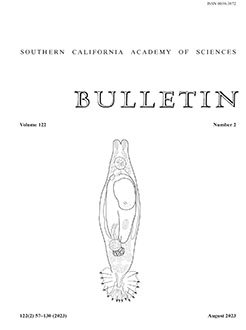A survey of Fundulus parvipinnis parvipinnis from coastal waters of Central and Southern California for Monogenea revealed two new species of Gyrodactylus Nordmann, 1832, Fundulotrema prolongis (Hargis, 1955) (both Gyrodactylidae), and a new species of Salsuginus Beverley-Burton, 1984 (Ancyrocephalinae). Gyrodactylus kalmanae n. sp. and F. prolongis attached primarily to the fins and body surface. Gyrodactylus parvipinni n. sp. was on the gills, fins, and body surface and, in some fish, formed dense aggregations on tips of gill lamellae and at the base of fins. Salsuginus californiensis n. sp. attached between adjacent secondary lamellae of the gill filaments. Partial 18S and ITS region (ITS1/5.8/ITS2) sequence data for the two new species of Gyrodactylus linked distantly to species from estuarine and marine fishes, but for F. prolongis were 100% and 99.88% similar, respectively, to samples from Fundulus heteroclitus in eastern North America. Salsuginus californiensis n. sp. differs from 11 previously described species of the genus in features of the accessory piece of the male copulatory organ and details of the larval hooks, with the molecular data reported herein being the first for this genus. The occurrence of Salsuginus from coastal California and western Mexico suggests this genus occurred on ancestral fundulids prior to isolation of Pacific species from eastern relatives by the Isthmus of Panama, estimated at 3 to 3.5 mya. Whether G. parvipinni n. sp. and G. kalmanae n. sp. have origins on ancestral fundulids or were acquired from local hosts after isolation is unclear at this time, but both species appear unrelated to species of Gyrodactylus from fundulids on the east coast. The finding of F. prolongis in California with almost identical 18S and ITS regions to eastern populations raises the question of its origin. Given the morphological and genetic similarities with populations on the east coast, F. prolongis (reported from a variety of eastern fundulid and related hosts) may have arrived via several related eastern host species introduced to and established in the state. If so, F. prolongis is a non-native species.
How to translate text using browser tools
14 July 2023
Gyrodactylus, Fundulotrema, and Salsuginus Species (Monogenea) Infecting Fundulus parvipinnis parvipinnis (Osteichthyes: Fundulidae) in Central and Southern California Estuaries and Bays
David K Cone,
Ralph G. Appy,
Eric M. Leis
ACCESS THE FULL ARTICLE





